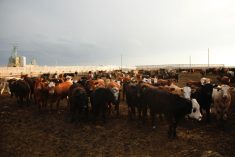CNS Canada — Despite now being approved for human consumption, demand for canary seed still hasn’t taken flight — and that’s being reflected in lower prices, one industry specialist says.
The largest source of pressure in Canada’s canary seed market is weak demand, according to David Nobbs, chair at the Canaryseed Development Commission of Saskatchewan in Kindersley.
Demand for canary seed is down about 20-30 per cent, Nobbs estimated, and he doesn’t expect the issue to be resolved any time soon.
“Weeks turn into months and months turn into quarters, and the lack of disappearance of product is weighing on the market.”
Read Also

Alberta crop conditions improve: report
Varied precipitation and warm temperatures were generally beneficial for crop development across Alberta during the week ended July 8, according to the latest provincial crop report released July 11.
Advances in the Canadian dollar have limited exporter ability to drop prices in an attempt to stimulate demand, he added.
Earlier in the year, when the Canadian dollar was at its cheapest since 2003, grower return was about 27 cents per pound — but the loonie has now strengthened from those lows.
“It flip-flopped the other way,” Nobbs said. “It’s coming right out of the grower price.”
Canary seed’s spot prices are now about 24 cents per pound.
Gains in the Canadian currency have left destination sales at a stalemate, but it’s not the only reason demand is sluggish.
“There’s virtually no new-crop business on the books, which is unusual,” Nobbs said. “Buyers are just not forward buying it.”
Canary seed was oversupplied at the end of the last crop year, as marketers pulled demand forward on drought concerns, causing the market to rally up to 30 cents per pound.
Now the market is sufficiently supplied, and buyers have gone from being speculative to slowly grinding through purchases in a market that’s steadily moving lower.
“People start to wonder, buyers start to question the values that canary seed is at,” Nobbs said.
Current prices are still fair, Nobbs said, but the problem is he doesn’t see those values holding, even at the relatively weak 24-cent level.
“There is no demand. In fact, in 13 years I don’t even know if I’ve seen it this slow,” he said.
Looking to the growing season ahead, acres are expected to edge down slightly, according to early estimates.
“We’re going to lose acres on one side of the province, we’re going to gain acres on the other side,” Nobbs said.
Saskatchewan grows nearly all of Canada’s canary seed.
Nobbs said he expects acres will come down in durum-growing areas, predominantly in eastern Saskatchewan, but will advance in wheat growing areas, which are mostly in the west.
“The euphoria over lentils is also going to take some acres from canary seed,” he added.
Seeded acres of canary seed are pegged at 321,000 acres this season, compared with 326,000 the year prior, Agriculture and Agri-Food Canada said.
— Jade Markus writes for Commodity News Service Canada, a Winnipeg company specializing in grain and commodity market reporting. Follow her at @jade_markus on Twitter.



















